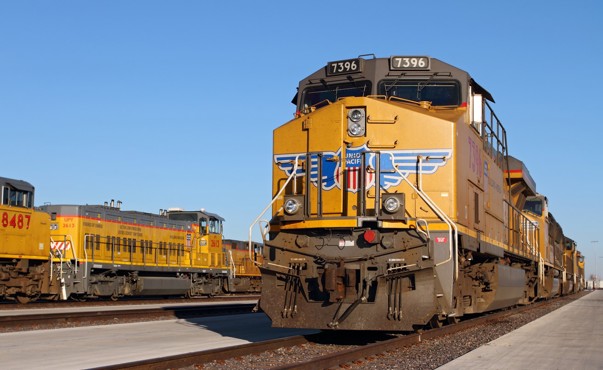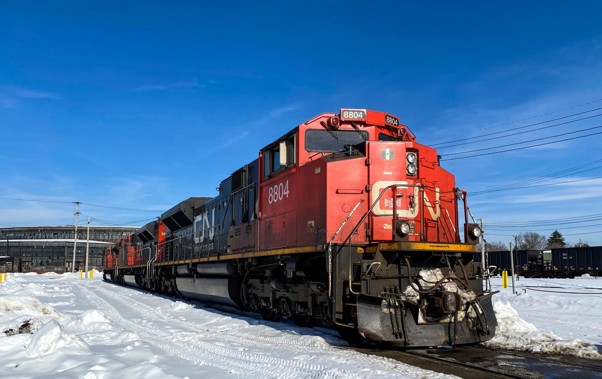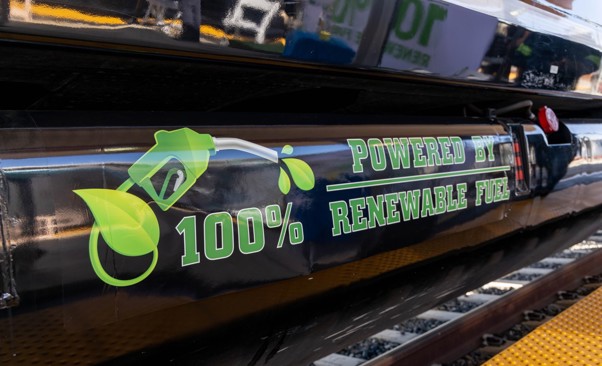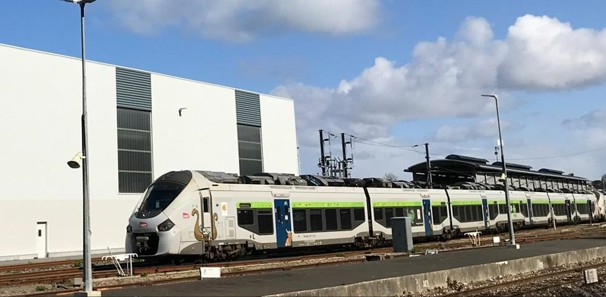Union Pacific (UP) operates 5,200 locomotives over 32,200 track-miles across 23 states west of the Mississippi, consuming 909 million gallons of diesel in 2022. Its aggressive decarbonization goals target 26% greenhouse gas (GHG) emissions-reduction by 2030 and net-zero by 2050. But with serviceable battery-electric and hydrogen trains still years away, like many railroads UP expects to achieve its nearer-term goals by adopting biofuels.
“Locomotives produce 95% of our emissions,” says Union Pacific assistant VP, fuel and environmental, Mark Lutz. “Built to run on diesel, we can only make them so efficient. Our 2050 goals require different technology, and we’ve committed US$100m to battery-electric locomotives. But to meet our 2030 targets, we’re focused on biodiesel and renewable diesel.”
These come from organic triglyceride feedstocks – soybean oil, animal fat, even used cooking oil. Biodiesel is an oxygenated fuel made by reacting triglycerides with methanol to form methyl esters. Renewable diesel uses a more traditional refining process to combine triglycerides with hydrogen, creating paraffinic hydrocarbons. Europeans call biodiesel FAME (fatty acid methyl ester) and renewable diesel HVO (hydrotreated vegetable oil).
“Both are low-carbon diesel alternatives,” adds Progress Rail’s director of advanced energy, Michael Cleveland. “They are differentiated by production method and some of their resultant qualities. Renewable diesel is almost indistinguishable from petroleum diesel with fewer technical risks, whereas biodiesel has a few watchouts but is currently more plentiful.”

Above: Union Pacific aims to reduce greenhouse gas (GHG) emissions by 26% by 2030 and achieve net-zero by 2050
Blending bio and renewable diesel
Being like diesel, burning them still generates CO2 emissions and their sustainability rests on overall lifecycle analysis. Since they absorbed or consumed carbon as plants or animals, crunching the numbers affords them 50% less carbon-intensity than fossil-derived diesel. Stated reductions in NOx and PM emissions can vary widely between fuels and engines. Blending the two fuels can optimize performance.
“Each has different properties,” explains Wabtec VP of product management, Robert Bremmer. “Biodiesel tends to swell elastomers, whereas renewable diesel shrinks them. Blending protects components by compensating for weaknesses in either fuel.”
Leading supplier Chevron Renewable Energy Group (REG) considers biofuels not just an expedient short-term bridge, but integral to longer-term decarbonization. Its UltraClean BlenD consists of 20% biodiesel and 80% renewable diesel – B20 R80 – optimized for drop-in replacement in diesel locomotives.
“Biodiesel has enhanced lubricity,” says Chevron REG sales and marketing VP, Todd Ellis. “Renewable diesel has a more desirable cloud-point. Blending brings out the best of both. It can lower emissions and improve cold-weather performance. We optimize the elements customers need and ensure quality-integrity across the supply-chain.”
Mitigating component degradation
Locomotive manufacturers Wabtec and Progress Rail want to support the decarbonization goals of their customers, the railroads. Wabtec has approved the use of blends up to B5 and R30 in existing diesel locomotives and Progress has approved up to B20 in EMD 710- and 645-series engines. But approving higher blends requires better understanding of component impacts over time.
“Globally, Wabtec has 24,000 deployed locomotives,” adds Bremmer. “We haul 80% of freight in North America. We’re the backbone – and must ensure, in supporting their decarbonization effort, we avoid creating performance or reliability issues for our customers and continue adhering to Environmental Protection Agency (EPA) emissions regulations.”
In locomotive engines, diesel flows continuously through intricate fuel-injector nozzle-tips, causing them to degrade over time. Novel fuel chemistries could accelerate nozzle-tip degradation and cause incomplete fuel-burn, increasing emissions and potentially jeopardizing EPA emissions-compliance. Rubber components, such as seals, couplings and gaskets, could degrade quicker due to variations in biofuel elastomer compatibility.
“We’ve partnered with industry experts to specify the updated elastomer chemistries needed to ensure resilience to certain blends,” explains Bremmer. “Ultimately, we plan to offer a biofuel upgrade kit enabling engines to operate with any approved blend or mitigate component degradation with shorter maintenance intervals.”
Union Pacific test-programs with both Wabtec and Progress Rail will establish the engine impacts of blends up to B20 and R80. Other class one railroads are running parallel tests on different Wabtec engine families.
“The OEMs need data to validate that engines can indeed run reliably and meet emissions standards with different biofuel blends,” Lutz explains. “After nearly a year, nothing we’ve seen causes us concern. But we need three years of testing, because certain problems may only appear over time.”
Environmental testing

Above: Canadian National Railway operates 18,600 miles of freight railway and targets 43% emissions intensity reduction by 2030
Biofuels are not new. For years, Wabtec and Progress locomotives have operated on various blends in countries like Brazil and Indonesia with a desire to use natural resources like sugar cane and palm oil as fuel feedstocks. This informs their caution on questions such as biodiesel’s higher cloud-point: the temperature at which it solidifies into wax.
“We were the first major manufacturer to endorse B20 across our fleet of over 26,000 in-service freight locomotives,” says Progress Rail director of power products and systems management, Michael Klabunde. “Our field-tests focus on durability and reliability, but also seasonality impacts. In cold climates, the fuels could wax and clog filters. In warmer weather, biodiesel promotes algae growth, which could create storage issues.”
As Bremmer observes, algae in your fuel-tank is far from optimal. Progress and Chevron have partnered with Canadian National Railway (CN) to conduct the first real-winter tests of blends including UltraClean BlenD in Greenville, Pennsylvania. CN operates 18,600 miles of freight railway and targets 43% emissions intensity reduction by 2030.
“This program involves stationary tests and field-tests over an extended period with a captive fleet,” Klabunde explains. “The time element equates to fuel-burn and how much fuel goes through the engine. We’re gathering a knowledge-base to understand how our equipment can work with whatever blends railroads have available.”
“Lab tests provide accelerated answers on fuel properties and material compatibility,” adds Cleveland. “Stationary tests help understand performance, emissions and fuel-consumption. Field tests depict reliability and durability over time. Our industry must synthesize all three avenues into a cohesive approach.”
This inherently cautious endeavor is designed to eliminate risk. Conclusions would be premature as field-tests with UP, CN and others continue toward purposely distant end-points. But thus far, nobody has observed any major problems.
“Every six months, we complete an emissions test to ensure we remain compliant with our certification,” adds Bremmer. “We do mechanical teardown of components to evaluate any degradation impacts. A year from now, we should have enough data to issue guidance or approval for up to B20 and R80, allowing railroads to operate 100% biofuel.”
Supply constraints
In Los Angeles, Metrolink has forged ahead in switching its entire passenger fleet to 100% renewable diesel (see Metrolink’s green journey in Southern California, below). Its newest EMD F125 locomotives run on Caterpillar C175 Tier Four engines, markedly different to those of most freight locomotives in service today and comparatively biofuel-tolerant.
“Don’t delay,” counsels Metrolink’s director of sustainability, Lisa Colicchio. “Do your own due diligence. Talk to your manufacturers to ensure you won’t void any warranties. Ensure fuel suppliers have the required quantities. Do a pilot test. But we’ve done the research and can attest that it works like a miracle.”
“Sometimes, individuals in hard-to-decarbonize sectors think the only solutions are a decade from scalability,” adds Chevron REG’s Ellis. “But we’re here today. We’re in the infrastructure. We’re ready to engage. Once we start the conversation and understand our collective resources, we can quickly find solutions to meet aggressive decarbonization schedules.”
Metrolink’s forward position is supported by plentiful supply of renewable diesel in California, where the California Air Resources Board (CARB) approves and incentivizes its use. Further east, renewable diesel is vanishingly scarce, but suppliers are building or retooling to meet demand. In Geismar, Louisiana, Chevron REG will expand renewable diesel production from 90 million to 340 million gallons per year by 2024.
“Supply is the greatest constraint,” says Progress Rail’s Cleveland. “Performance and durability are technical issues we can solve. As supply grows, so will acceptance and confidence. But states, railroads and engine manufacturers are all coming from different starting-points, so transition is uneven and meandering.”
“Government can make a difference,” adds Union Pacific’s Lutz. “California’s Low-Carbon Fuel Standards and willingness to subsidize renewable diesel has brought supply online. Illinois offers a tax discount for using biodiesel. We advocate that all states consider similar subsidies.”
Chevron REG, meanwhile, is invested in new and emerging crops to support future feedstock abundance. Renewable diesel costs three times as much as petroleum today and while supply may increase, Bremmer expects rising demand to keep its price high. Since biodiesel is less energy-dense than diesel, 5%-8% more is needed to produce the same energy. Railroads may pay a premium on fuel to achieve near-term decarbonization but defer the cost of radical new infrastructure for battery or hydrogen transition.
“The handling and storage infrastructure is already there,” says Progress Rail’s Klabunde. “Railroads can make immediate emissions reductions without major operational changes. Fundamentally, biofuels will provide a bridge to the next future state…as that future state evolves.”
Metrolink’s green journey in Southern California

Image above courtesy of Metrolink
In February 2021 Metrolink became the first US rail agency to run all its locomotives on 100% renewable diesel, or hydrotreated vegetable oil (HVO). A drop-in replacement for the eight million gallons of diesel Southern California’s passenger operator consumed annually, it delivers a CO2 emissions-reduction reckoned equal to retiring 14,000 cars.
“It contains no fossil fuel,” says Metrolink’s sustainability director, Lisa Colicchio. “It’s refined just like petroleum diesel and contains lubricants, so engines don’t know the difference. It reduces CO2 up to 80%, based on lifecycle analysis and its prior life as a plant, and reduces other Clean Air Act criteria pollutants.”
Metrolink’s green journey started ten years ago with a US$250m investment in the clean-burning Tier Four locomotives now comprising 75% of its fleet. On renewable diesel, it followed the lead of Californian agencies Capitol Corridor and the City of Oakland, whose vehicles run on the fuel.
“We pilot-tested it for a year,” explains Colicchio. “We checked filters, climbed steep grades without losing horsepower and got the same miles-per-gallon as diesel. There was no retrofit, no cost, literally no downsides: it felt like an untapped secret.”
During procurement, several suppliers confirmed there was no shortage of renewable diesel in and beyond the Golden State. “Demand is increasing, especially from airlines,” says Colicchio. “Oil refineries are closing and retooling to process natural fats and oils. California’s regulatory environment means renewable diesel is cheaper than diesel for Metrolink, so we’re saving our bottom line and the planet.”
Renewable diesel doesn’t eliminate all emissions. Eventually, Metrolink aims to achieve zero with battery or hydrogen trains but acknowledges collective transition will take years and cost billions of dollars. By contrast, renewable diesel is cost-neutral and here now.
“It’s a bridge for today,” says Colicchio. “When it’s readily available, why wouldn’t you use it? It seems the responsible path.”
How biofuels are enabling rapid decarbonization for France’s SNCF

SNCF Transport Express Régional (TER) trains produce just 23g of CO2 per passenger km, versus 193g for single-occupancy cars. TER’s PlaneTER program targets a further one-third reduction and while more than 70% of its trains today can use electric traction, by 2050 it anticipates complete diesel phase-out.
“We’re studying four solutions: biofuels, then hybrid, battery-powered and hydrogen trains,” says TER fleet decarbonization manager, Stéphane Chwalik. “Biofuels allow rapid decarbonization without significant rolling-stock modifications and offer a link between our current operations and more ambitious future technologies.”
Since April 2021, Paris-Granville line Régiolis trains have run on 100% biodiesel (B100) made from rapeseed. According to TER, B100 produces 60% less greenhouse gas emissions than fossil diesel and Paris-Granville implementation has already saved 13,000 tons of CO2 (equivalent to the annual footprint of 1,500 French citizens).
“We took particular care testing the fuel,” adds Chwalik. “First, engine bench-tests confirmed the performance on regulated polluting emissions: fine particles, carbon monoxide and unburned hydrocarbons. We then launched a full-scale experiment to measure the impact on train operations, followed by precise analysis of maintenance impacts.”
Results over a six-month test-period confirmed that an adapted maintenance schedule will enable trains to continue using rapeseed-derived B100 without engine modifications. Further tests in Bourgogne-Franche-Comté have assessed its cold-weather performance and TER also plans to test hydrotreated vegetable oil (HVO) fuel. The B100’s low-impact production avoids land-use competition with food.
“It’s a rapeseed industry co-product not derived from dedicated crops,” Chwalik explains. “One hectare of rapeseed can simultaneously produce 1,900kg of animal-feed, 500l of edible oil and 1000l of biofuel.”
In Germany, Deutsche Bahn (DB) is embracing biofuels, including HVO produced from biological residue and waste. DB Cargo has tested 100% HVO in locomotives, DB Regio has run HVO-powered passenger trains and long-distance Westerland-Niebüll shuttle trains avoid emitting 7,500 tons CO2 annually using the fuel.
*This article first appeared in the March 2023 issue of Electric & Hybrid Rail Technology magazine.

